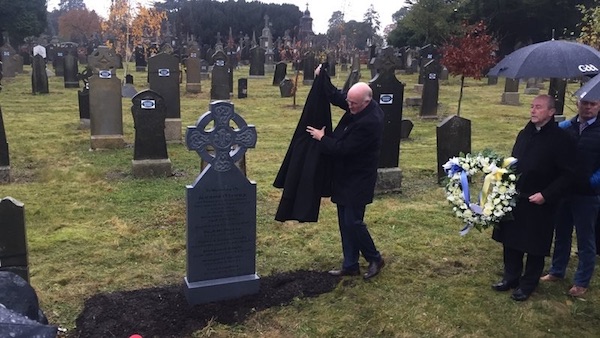
The last three unmarked graves of the 14 people killed un the first Bloody Sunday massacre in Dublin 99 years ago have been replaced with commemorative headstones.
The headstones were unveiled during a ceremony in Glasnevin Cemetery for the youngest victim - 10-year-old Jerome O’Leary - along with Patrick O’Dowd, 57, and 40-year-old Michael Feery.
On 21 November 1920, British forces opened fire in Croke Park during a football match between Dublin and Tipperary killing 14 people and injuring dozens of others.
The attack was in retaliation for the IRA attack on a British spy network, the ‘Cairo Gang’, earlier that day. The infamous massacre saw a blizzard of bullets directed into the stands which lasted 90 seconds.
Some of the victims were buried in unmarked graves like many of the poor of that era. The last of the blue marble headstones have now been unveiled, paid for by the GAA through its Bloody Sunday Graves Project.
Little Jerome O’Leary had been lifted onto the wall at the back of the Canal End by another spectator so he would get a better view of the match. He was the second victim shot dead.
He was the son of a British soldier, also called Jerome. He is the only one of the three children killed that day for whom a photograph still exists. He is now part of the “Bloody Sunday family”, according to journalist and author Michael Foley.
“Anybody who is ever 10 years of age and went to a match, imagine the excitement. Jerome would have had the same anticipation.”
The exact last resting place of Michael Feery is not known. He is buried along with 35,000 others in a mass common grave now covered with grass in the St Paul’s cemetery extension of Glasnevin.
Feery was shot dead by the same army he fought for in the first World War. He died from a thigh wound after he became impaled on a spike while trying to flee the shooting. He lay in a morgue unclaimed for five days, and was wearing at the time of his death his old army fatigues.
Liam Dineen, the grand-nephew of Patrick O’Dowd, cried as he remembered his aunt who was left without a father as a consequence of Bloody Sunday.
“She often wondered what would be done to honour his memory. He was shot helping other people down over the back wall. One man he helped down felt this body falling on top of him. That was Patrick O’Dowd,” he said.
“I am very proud to recognise the significance of this moment. My aunt is long dead, but she will rest easy today knowing her father is now recognised.”
Mr O’Dowd came from Buckingham Street. He worked as a labourer for Clarkes Builders in Fairview.
Mr Dineen said there was no apology about his death and it was always talked about with regret, sorrow and sadness.
He said his aunt “missed him for the rest of her life and she never had closure ... he went to a match and never came home”. But he described the ceremony as “an honour” which would generate treasured memories for him that he could pass on to future generations.
![[Irish Republican News]](https://republican-news.org/graphics/title_gifs/rn.gif)
![[Irish Republican News]](https://republican-news.org/graphics/title_gifs/harp.gif)

